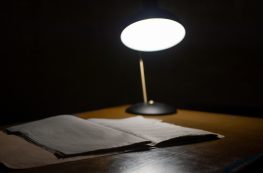In 1965, Col. Thomas “Jerry” Curtis’s helicopter was shot down over North Vietnam. He was immediately captured and spent 7½ years confined in a filthy 5′ x 7′ cell at the notorious Hanoi prison camp. Thousands of miles from home and unable to communicate with his wife and children, Jerry endured months of solitary confinement, suffocating heat, freezing cold, grueling physical and psychological torture, constant hunger, and unimaginable mental duress. And yet, time and again, the Light that darkness cannot overcome became his beacon of hope.

During his time as a POW, Col. Curtis depended on secret communication with his fellow captives to relay vital information, and to keep morale up. The POWs used a secret tap code, and were able to communicated undetected.
In an excerpt from the book Under the Cover of Light, Col. Curtis describes the tap code in detail:
At an Air Force Survival School (before leaving the States) I heard an instructor tell about POWs in a German camp in World War II communicating between buildings by tapping on a common water pipe. As I left class, I found the instructor walking by me, so I asked him how they sent the dashes— thinking it was the Morse code. He quickly took me to the chalkboard and showed me the “tap code” they used.
It was a five-by-five matrix of the alphabet, omitting K. We used C for K. The first line was ABCDE, and the first column was AFLQV. To use the code, one would first tap one to five times to identify the A, F, L, Q, or V row, pause, and tap one to five times to identify the letter in that row. Thus the letter S would be tapped AFLQ, pause, QRS. I taught this code to the others in the large cell. Within a few days our captors put us all back in solitary confinement, and we successfully tapped to our comrades in adjacent cells. Recognizing the importance of communicating, we went to great lengths to ensure that every POW knew the tap code. It spread like a chain reaction.

The importance of communication between POWs cannot be overstated. It was a morale booster. It provided a vehicle for the POW chain of command to be utilized. It provided for shared information to counter the efforts of the enemy to divide the POWs and for POWs, under the direction of the senior ranking officer (SRO), to form a common resistance to their aims. It provided information from friends and family back home (from later shoot-downs). It provided educational opportunities from a wealth of knowledge (all POWs shared a need to make some productive use of time spent in prison). Communicating, clearing for guards, and all efforts to assist the communication process (not limited to just the tap code) used a great amount of time each day.
You can find Jerry’s full story in the new book Under the Cover of Light. Learn more HERE.
 From Under the Cover of Light by Carole Engle Avriett
From Under the Cover of Light by Carole Engle Avriett
In 1965, Col. Thomas “Jerry” Curtis’s helicopter was shot down over North Vietnam. He was immediately captured and spent 7½ years confined in a filthy 5′ x 7′ cell at the notorious Hanoi prison camp. Thousands of miles from home and unable to communicate with his wife and children, Jerry endured months of solitary confinement, suffocating heat, freezing cold, grueling physical and psychological torture, constant hunger, and unimaginable mental duress. And yet, time and again, the Light that darkness cannot overcome became his beacon of hope. Now, for the first time in print, Jerry shares the full story of his 2,703 days in captivity and what he learned about faith, hope, and the indomitable power of the human spirit.
Learn more HERE.




